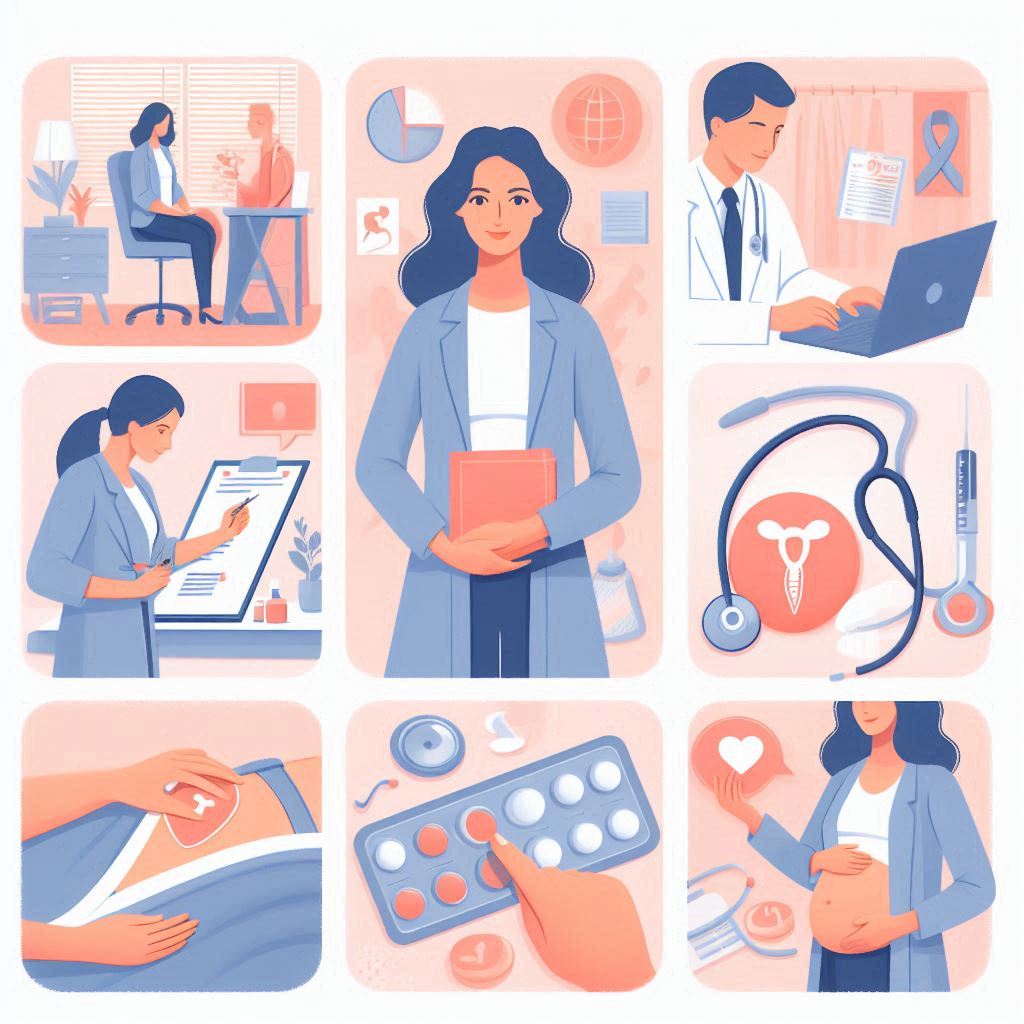Understanding the Importance of Partners in Women’s Health
Why Women’s Health Requires Specialized Care
Women’s health isn’t just a topic—it’s a necessity that shapes families, societies, and future generations. Women’s bodies go through unique physiological changes across their lifespan: menstruation, pregnancy, childbirth, and menopause. Each phase brings its own set of health challenges and considerations. That’s why having specialized care for women isn’t just a luxury—it’s an absolute must.
From the first period to post-menopause, women face conditions like endometriosis, PCOS (polycystic ovarian syndrome), hormonal fluctuations, and more. These conditions don’t affect men and need targeted treatment protocols. Additionally, many diseases—such as heart disease—can present differently in women, making a generic healthcare approach inadequate. Specialized care ensures that early signs are caught and managed properly.
Doctors, midwives, therapists, and nurses who specialize in women’s health bring more than medical expertise—they offer empathy, understanding, and insights tailored specifically to the female experience. The goal isn’t just treatment but empowerment. When a woman understands her body, she’s better equipped to make informed decisions about her health, relationships, and lifestyle.
The healthcare industry is finally recognizing that a “one-size-fits-all” model doesn’t work. Women’s health needs a dedicated lens, from research to clinical practices, to ensure every woman gets the care she truly deserves. It’s not about being different for the sake of it—it’s about being specific to be effective.
Key Differences in Men’s and Women’s Health Needs
Let’s get one thing straight: biology matters. Women metabolize drugs differently, process stress uniquely, and even present heart attack symptoms that often go unnoticed due to medical standards based on male-centric research. That’s why focusing on the distinct aspects of women’s health is crucial.
For instance, autoimmune diseases like lupus and rheumatoid arthritis are more common in women. Mood disorders like depression and anxiety often stem from hormonal shifts, especially during menstruation, postpartum, or menopause. Even bone health, which may seem unrelated, is a huge concern due to osteoporosis being significantly more common in post-menopausal women.
The mental and emotional aspects are just as vital. Women often take on caregiver roles and face societal pressures that can affect their psychological well-being. Recognizing these differences leads to more compassionate, comprehensive healthcare. So, when we talk about the importance of women’s health, we’re not talking about splitting hairs—we’re talking about survival, strength, and self-care.

What Are Partners in Women’s Health?
The Concept of Partnership in Women’s Wellness
“Partners in women’s health” isn’t just a catchy phrase—it’s a revolutionary concept. Imagine a healthcare model where every woman feels supported, informed, and empowered throughout her health journey. That’s what true partnership means: not just treating patients, but teaming up with them.
Partnership starts with communication. Healthcare providers who listen to your concerns, validate your feelings, and guide you without judgment are essential. Women aren’t just passive recipients of care—they’re active participants. When both sides work together, health outcomes improve dramatically.
A good partner in women’s health doesn’t just write prescriptions—they ask questions. They walk you through options, discuss side effects, explore lifestyle choices, and follow up. Whether it’s a family doctor, a midwife, a gynecologist, or a therapist, they’re part of a support network that puts your health first.
This concept also extends to emotional and social wellness. Having a partner means having someone in your corner when navigating tough diagnoses, fertility challenges, or postpartum depression. It’s about trust, continuity, and compassion. And when done right, it feels like you’re finally being seen and heard.
Types of Healthcare Providers Involved
Let’s break down the team. Who exactly are your partners in women’s health?
-
OB/GYNs (Obstetricians/Gynecologists): These specialists focus on the reproductive system and are key players in managing menstrual health, fertility, pregnancy, and menopause.
-
Midwives: Certified professionals who provide holistic, woman-centered care during pregnancy, childbirth, and postpartum. They’re known for their natural approach and deep emotional support.
-
Primary Care Physicians (PCPs): Your first line of defense for general wellness and preventive care. They coordinate with specialists as needed.
-
Nurse Practitioners (NPs): Trained to diagnose, treat, and educate, especially helpful in community clinics and women’s health centers.
-
Mental Health Professionals: Therapists, psychologists, and psychiatrists address emotional well-being, postpartum issues, trauma, and stress-related conditions.
-
Endocrinologists: Experts in hormones—crucial when dealing with thyroid problems, PCOS, or menopause.
It’s not just about finding a doctor—it’s about assembling a team that works for you. And when each provider respects your goals, beliefs, and concerns, that’s where the real magic happens.

Services Offered by Partners in Women’s Health
Gynecology and Obstetrics
If there’s one area where women need trusted experts, it’s gynecology and obstetrics. These fields form the core of women’s health services. Gynecology deals with the general health of the female reproductive system—think periods, pap smears, birth control, and infections. Obstetrics, on the other hand, is all about pregnancy, childbirth, and postpartum care.
Let’s start with gynecology. Annual checkups, pelvic exams, and cervical screenings are the norm. If you’re sexually active, have irregular periods, or notice pain or unusual discharge, your gynecologist is your go-to partner. They’re also the ones to talk to about birth control, STIs, and reproductive planning.
Obstetrics kicks in when you’re thinking of having a baby—or already expecting one. Regular prenatal visits monitor your baby’s growth, check for complications, and ensure you stay healthy. A good OB will guide you through everything from nutrition to labor plans, helping reduce anxiety and boosting confidence.
But it’s more than clinical visits. These providers are emotional anchors. They help you handle fertility issues, miscarriages, and even unplanned pregnancies. They offer guidance without judgment, giving you the knowledge to make the best decisions for your body and your future.

Preventive Screenings and Annual Exams
Pap Smears and HPV Testing
Pap smears are like your health’s early warning system. Simple, quick, and super important, these tests can detect abnormal cells on the cervix long before they turn into cervical cancer. When combined with HPV (human papillomavirus) testing, they become even more powerful in preventing disease.
Here’s the thing—HPV is super common. Nearly 80% of sexually active women will get it at some point. Most of the time, the body clears it on its own. But certain strains, if left unchecked, can lead to cervical cancer. That’s why regular screenings matter. Starting at age 21, women should begin Pap smears every three years, or more frequently if they’ve had issues in the past.
HPV tests are often done in tandem with Pap smears, especially for women over 30. The combo is called co-testing and provides a more accurate picture. If you’re over 30 and both tests come back negative, you may be able to stretch your exams to every five years.
Still nervous about getting a Pap smear? That’s normal. But the discomfort is minimal, and the payoff is huge. These tests save lives. Period. And if something’s off, early treatment can make all the difference.
Bone Density Testing and Osteoporosis Prevention
Most people don’t think about their bones until they start creaking. But for women—especially post-menopausal ones—bone health is a serious concern. Estrogen helps maintain bone density, and when levels drop after menopause, bones can weaken quickly, leading to osteoporosis.
A bone density test, often called a DEXA scan, measures how strong your bones are. It’s painless and takes just 10–15 minutes. Doctors usually recommend this test for women over 65, or younger if they have risk factors like a family history, low body weight, or early menopause.
So what can you do to prevent osteoporosis? Calcium and vitamin D are your best friends. Dairy, leafy greens, and supplements help build bone strength. Regular weight-bearing exercises—like walking, dancing, or resistance training—also go a long way.
Don’t wait until a fracture to care about your bones. Preventive testing and healthy habits can save you a lot of pain—and keep you on your feet for years to come.

Life Stages and Health Needs of Women
Adolescent and Teen Health
Ah, the teenage years—a whirlwind of growth, emotion, and transformation. This is when many girls experience their first period, develop physically and emotionally, and face new social pressures. It’s also the perfect time to start a relationship with a women’s health provider.
Adolescent gynecology doesn’t mean internal exams from day one. It’s often more about conversation and education. Teens can learn about menstrual hygiene, what’s normal and what’s not, and how to manage cramps or heavy bleeding. Providers can also address body image, sexual health, and mental wellbeing in a safe, non-judgmental environment.
For teens who are sexually active—or thinking about it—it’s crucial they have access to accurate information about birth control, STIs, and consent. Having a trusted provider can make all the difference. Parents should encourage open dialogue but also allow their teens some privacy during appointments to build trust with their provider.
Vaccinations also play a big role at this stage. The HPV vaccine is usually recommended between ages 11 and 12 but can be given up to age 26. It’s a powerful tool in preventing certain cancers later in life.
Reproductive Years and Fertility Support
Between the ages of 20 and 40, women often experience their most intense health needs. From contraception to pregnancy planning and fertility concerns, this stage is packed with decisions—and your healthcare partner should be right there with you.
If you’re not planning on kids, your OB/GYN can walk you through the full range of contraceptive options: pills, IUDs, implants, patches, or natural methods. No two women are alike, and what works for one might not for another.
For women ready to conceive, fertility discussions come into play. It’s not just about “trying.” It’s about understanding your cycle, tracking ovulation, and identifying any underlying conditions that could affect fertility—like PCOS, fibroids, or endometriosis.
If pregnancy isn’t happening naturally, don’t panic. There are many paths—from lifestyle adjustments and medication to advanced treatments like IUI or IVF. The key is early and honest conversations with your provider. Time matters when it comes to fertility, so don’t delay seeking support.
Menopause and Post-Menopausal Care
Menopause isn’t a sudden switch—it’s a journey. And like any major transition, it comes with challenges. Hot flashes, mood swings, night sweats, sleep disturbances, and a shifting metabolism are just a few of the issues many women face during this time.
Menopause usually starts between ages 45 and 55. Perimenopause—the years leading up to it—can last up to a decade and often brings irregular periods and hormonal chaos. It’s during this phase that many women seek relief and guidance from healthcare partners who understand the full picture.
Hormone replacement therapy (HRT) is one option, though not for everyone. Some women benefit from it immensely, while others may prefer natural remedies or lifestyle changes. Your provider can help weigh the pros and cons, taking into account your personal health history.
Post-menopausal care is just as vital. Bone density, heart health, vaginal dryness, and urinary issues can crop up and shouldn’t be ignored. This phase is all about quality of life—and yes, sexual health still matters too!

Common Health Concerns Addressed
Breast Health and Mammograms
Breast health is a cornerstone of women’s wellness. Regular self-exams, clinical exams, and mammograms are all part of a proactive approach to detecting problems early—especially breast cancer, which remains one of the most common cancers affecting women globally.
Most healthcare providers recommend that women start monthly breast self-exams in their 20s. Knowing what’s normal for your body helps you detect any changes early—like lumps, swelling, dimpling, or unusual discharge. If you notice anything out of the ordinary, don’t wait. Contact your doctor right away.
When it comes to mammograms, the general guideline is to begin annual screenings at age 40. However, if you have a family history of breast cancer or genetic factors like the BRCA1 or BRCA2 mutations, your doctor might suggest starting earlier.
Mammograms can detect lumps or abnormalities before they’re even palpable. That’s what makes them so powerful. While the test might be a bit uncomfortable, it’s quick and can literally save your life. Your healthcare partner will also monitor for benign breast conditions, cysts, or infections that may arise at different life stages.
Early detection is not just a medical strategy—it’s a lifesaver. Combine mammograms with self-awareness and provider support, and you’ll be giving yourself the best chance for long-term breast health.
Menstrual Disorders and Pelvic Pain
Let’s be real—periods can be a pain. But chronic, debilitating pain or irregular bleeding isn’t something to just “tough out.” Conditions like endometriosis, fibroids, PCOS, and adenomyosis are real, common, and often misunderstood. Partners in women’s health are there to diagnose and treat these issues compassionately and thoroughly.
Endometriosis affects roughly 1 in 10 women and can cause painful periods, painful sex, and even infertility. It often goes undiagnosed for years due to a lack of awareness—even among medical professionals. Pelvic exams, ultrasounds, and sometimes laparoscopy are used to confirm the diagnosis.
Fibroids are another culprit. These benign tumors in the uterus can cause heavy bleeding, back pain, and frequent urination. PCOS, meanwhile, disrupts hormonal balance, affecting ovulation, skin health, and weight. Each of these disorders requires a personalized approach.
Whether you’re dealing with cramping that knocks you off your feet or cycles that are completely unpredictable, you shouldn’t have to suffer in silence. The right healthcare provider won’t dismiss your pain—they’ll dig deeper to find solutions.
Hormonal Imbalance and Thyroid Health
Hormones are like the orchestra conductors of your body. When they’re in tune, everything runs smoothly. But when even one instrument is out of sync, chaos follows—fatigue, mood swings, weight gain, acne, irregular periods, and more.
Hormonal imbalances can arise from a variety of causes—stress, diet, sleep, or underlying health conditions. Thyroid disorders, for instance, are especially common in women. Hypothyroidism (underactive thyroid) can make you feel sluggish and cold, while hyperthyroidism (overactive thyroid) may lead to anxiety, weight loss, and a racing heart.
Testing your hormone levels—like estrogen, progesterone, cortisol, insulin, and thyroid hormones—can help pinpoint the root cause of your symptoms. Your provider might recommend blood tests, saliva panels, or even ultrasound imaging of the thyroid.
Treatment may include hormone therapy, lifestyle changes, or medication. And here’s where a real partner in your health shines—they’ll take the time to explain the results, talk through treatment options, and support you every step of the way.

Nutrition and Fitness for Women’s Health
Role of Diet in Hormonal Balance
Food is more than fuel—it’s medicine. And when it comes to hormonal health, the right nutrition can be a game-changer. Eating whole, balanced meals supports everything from your menstrual cycle to your mental health. And trust us, your hormones are paying attention to what’s on your plate.
Let’s start with key nutrients. Healthy fats—like those found in avocados, nuts, seeds, and olive oil—help regulate estrogen and support reproductive health. Complex carbs (like quinoa and brown rice) stabilize blood sugar, which is closely tied to hormone production. Lean proteins aid in tissue repair and metabolic function.
Cruciferous vegetables (think broccoli, kale, and Brussels sprouts) are superstars for detoxing excess estrogen. Omega-3s found in salmon, chia seeds, and flaxseeds help reduce inflammation and support mood. And don’t forget hydration—it affects everything from digestion to skin health.
Avoiding highly processed foods, excess sugar, and caffeine can also reduce PMS symptoms, acne, and fatigue. And if you’re struggling with conditions like PCOS or endometriosis, working with a nutritionist or functional medicine provider can help you create a diet plan that truly supports healing.
Exercise Routines for Different Ages
Movement is medicine—and women need different types of movement at different stages of life. From bone health to heart health, the benefits of exercise go way beyond burning calories.
In your 20s and 30s, mix cardio, strength training, and flexibility workouts. This is the time to build lean muscle, boost metabolism, and improve mood. Think jogging, HIIT, yoga, and resistance training. It’s also a great time to develop lifelong fitness habits.
In your 40s and 50s, your metabolism may slow, and muscle mass naturally begins to decline. Prioritize strength training to maintain bone density and muscle tone. Add in low-impact cardio like swimming or cycling to protect joints. Pilates and yoga are fantastic for flexibility and stress relief.
Post-menopause? Keep moving! Walking, dancing, water aerobics—whatever keeps you active and happy. Exercise reduces your risk of chronic disease, improves balance (hello, fall prevention), and keeps your brain sharp.
No matter your age, consistency beats intensity. And your healthcare team can help tailor a fitness plan to fit your body’s unique needs.

Emotional Wellbeing and Mental Health
Anxiety and Depression in Women
Mental health is just as critical as physical health, and yet it’s often overlooked—especially among women who are used to “holding it all together.” But anxiety and depression are not just passing moods. They’re real medical conditions, and they deserve real attention.
Women are almost twice as likely as men to experience anxiety disorders and depression. Hormonal fluctuations, life changes, societal expectations, and trauma all play a role. It’s common during reproductive transitions, like puberty, pregnancy, and menopause.
Symptoms of anxiety may include constant worry, irritability, insomnia, and difficulty concentrating. Depression can manifest as persistent sadness, fatigue, hopelessness, and a lack of interest in things you used to enjoy. These symptoms are not signs of weakness—they’re signals that something’s off and needs support.
Partners in women’s health often work alongside therapists, counselors, and psychiatrists to create a comprehensive care plan. This may involve talk therapy, medication, lifestyle changes, or a combination. The important part? You don’t have to go through it alone.
Seeking help is a sign of strength, not failure. And with the right partner, healing is absolutely within reach.

Sexual Health and Intimacy Support
Addressing Painful Intercourse and Low Libido
Let’s talk about something often left unspoken—pain during sex and a drop in sexual desire. These are not just “in your head” or a “normal” part of aging. They’re real issues, and they deserve compassionate, professional attention.
Painful intercourse, or dyspareunia, can be caused by many things—vaginal dryness, hormonal imbalances, infections, or underlying conditions like endometriosis. It can also be linked to emotional factors like past trauma, stress, or relationship challenges.
Low libido is just as complex. Hormones, mental health, medications, and lifestyle can all affect your desire for sex. And the shame or frustration that comes with it? Totally unnecessary. This is where a provider who truly listens and understands women’s bodies and minds is essential.
Treatment options can include hormone therapy (like vaginal estrogen), lubricants and moisturizers, pelvic floor physical therapy, counseling, and addressing any relational dynamics that may be at play. Open communication with both your partner and your provider is key.
Healthy intimacy is possible at every stage of life, and it starts with feeling heard, validated, and empowered.

Supporting Women Through Chronic Conditions
Living With PCOS, Endometriosis, and Fibroids
Chronic conditions like polycystic ovary syndrome (PCOS), endometriosis, and uterine fibroids are more than just “women’s issues”—they’re life-altering diagnoses that require long-term management and personalized care.
PCOS affects hormone levels and metabolism, often leading to irregular periods, acne, weight gain, and infertility. It’s also linked to insulin resistance and a higher risk of diabetes. Management typically includes lifestyle changes, medications like Metformin or birth control, and in some cases, fertility treatments.
Endometriosis is when tissue similar to the uterine lining grows outside the uterus, causing severe pain, heavy periods, and sometimes digestive issues. Diagnosis is tricky and often delayed. Treatment may include hormonal therapy, pain relief, and sometimes surgery.
Fibroids are noncancerous tumors that can grow in and around the uterus. While some are symptom-free, others can lead to heavy bleeding, pelvic pain, and fertility issues. Treatment depends on size, location, and your life goals—options range from watchful waiting to myomectomy or uterine artery embolization.
Living with these conditions requires more than prescriptions—it requires a care team that understands the nuances and truly partners with you in your health journey.

Technology and Telehealth in Women’s Health
Benefits of Virtual Appointments
Modern healthcare isn’t confined to the doctor’s office anymore. With telehealth, you can connect with your provider from home, work, or even vacation. It’s convenient, private, and often just as effective as an in-person visit—especially for follow-ups, medication management, or mental health counseling.
Telehealth allows for real-time consultations, lab result reviews, and quick assessments for things like UTIs, birth control renewals, or hormone therapy discussions. It breaks down barriers like transportation, childcare, or time constraints.
Especially during and after the COVID-19 pandemic, telemedicine has proven to be a lifeline for women managing chronic conditions or seeking mental health support.
Still need a physical exam or lab work? Many providers offer hybrid care—start with a virtual visit, then follow up in person if needed. It’s about flexibility, accessibility, and putting your health back in your hands.

Empowering Women Through Education
Workshops, Classes, and Community Programs
Knowledge is power, and when it comes to women’s health, education can be life-changing. That’s why many women’s health clinics offer community workshops, classes, and wellness programs on everything from breastfeeding and menopause to yoga and nutrition.
These gatherings provide a chance to ask questions, share experiences, and feel less alone. For new moms, postpartum support groups can be a lifeline. For teens, puberty education helps ease anxiety. For older women, menopause classes can replace confusion with confidence.
Some clinics also host events for partners, helping spouses or support people understand what their loved ones are experiencing. It builds empathy and stronger relationships.
Whether it’s a Zoom call or a circle of chairs in a wellness center, these programs foster connection and growth—and help women make informed choices about their health.

Choosing the Right Partner in Women’s Health
What to Look For in a Women’s Health Provider
Not all providers are created equal. When choosing a partner in women’s health, you’re choosing someone who will walk with you through some of the most personal and powerful moments of your life. So how do you find the right one?
First, look for someone who listens—really listens. You want a provider who takes your concerns seriously, explains things clearly, and includes you in the decision-making process.
Check credentials and areas of expertise. Are they board-certified? Do they have experience with your particular condition or life stage? What services do they offer in-house?
Also, consider their philosophy. Are they open to holistic options? Do they value preventive care? Do they support your birth plan or fertility goals?
Finally, trust your gut. The right provider should make you feel seen, respected, and supported—because your health, your story, and your body deserve nothing less.

Conclusion
Partners in women’s health aren’t just about exams and prescriptions. They’re about advocacy, empowerment, and walking with you through every season of life. From adolescence to menopause, from fertility challenges to chronic conditions, from mental health to sexual wellbeing, women need healthcare that treats the whole person.
Whether you’re just starting out on your health journey or seeking a new provider who truly gets it, remember: you deserve more than care. You deserve a partnership.
Choose someone who listens. Choose someone who empowers. Choose someone who treats you like the expert of your own body.
FAQs
1. How often should I see a women’s health provider?
Generally, once a year for a well-woman exam. But you might need more frequent visits if you’re managing a condition or going through a life transition like pregnancy or menopause.
2. What should I expect at my first OB/GYN visit?
Expect a conversation about your health history, lifestyle, and any current concerns. Physical exams might be included depending on your age and symptoms—but nothing is done without your consent.
3. Is it normal to have irregular periods?
Occasionally, yes—especially during puberty, after childbirth, or nearing menopause. But consistent irregularities could signal a deeper issue like PCOS or thyroid dysfunction.
4. Can mental health issues affect physical health?
Absolutely. Stress, anxiety, and depression can lead to sleep problems, weight changes, hormonal shifts, and chronic inflammation. Treating mental health is essential for full-body wellness.
5. What’s the best way to prevent STIs?
Use barrier methods like condoms, get regular screenings, limit your number of partners, and have open conversations about sexual health with both your partner and your provider.
Sources used in this article
-
American College of Obstetricians and Gynecologists (ACOG)
ACOG provides comprehensive guidelines on women’s health, including preventive care, reproductive health, and menopause management. -
American Academy of Family Physicians (AAFP) – Women’s Health Resources
AAFP offers resources for family physicians to provide care for women across all life stages. -
Society for Women’s Health Research (SWHR)
SWHR focuses on eliminating imbalances in women’s health research and care through community partnerships. -
Commonwealth Fund – Transforming Primary Health Care for Women
This report presents a framework for addressing gaps and barriers in primary health care for women. -
Nova Women’s Health Partners
Nova supports independent women’s health practices through physician-led business resources. -
Global Women’s Health Partners – University of Minnesota
This initiative works with global partners to advance sustainable, equitable health for women and girls. -
Axia Women’s Health
Axia is a community of health professionals committed to providing comprehensive women’s health care. -
Together Women’s Health Partners with true. Women’s Health
This partnership aims to become a national leader in digital menopause and wellness care. -
Women’s Health – Sage Journals
An open-access, peer-reviewed journal focusing on all aspects of women’s healthcare. -
Unlocking Opportunities in Women’s Healthcare – McKinsey & Company
This article discusses advances in women’s healthcare and their implications for stakeholders.
Read about Women’s Fashion on HappiLife

